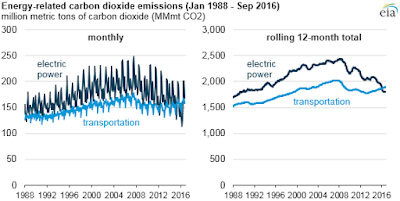A recent article on CNBC claims that the energy sector will hold North America together not matter what else happens.* A lot of progress has been made in reducing the carbon emissions from power plants:
The U.S. electric power sector consumes more energy than the transportation sector, which includes automobiles, planes and trains. Still, carbon emissions from power plants have managed to fall below those from transportation because carbon intensity from electric power generation has fallen faster.**
.................................................................
Natural gas facilities are also cheaper to build and operate, according to Robert Godby, director of the Center for Energy Economics and Public Policy at the University of Wyoming. New rules that require plants to install expensive technology to mitigate emissions, as well as the uncertainty of future regulations, have also dissuaded utilities from building new coal-fired plants, he told CNBC in an interview in December.**
(Click on figure to enlarge)
What we need is an evaluation of how much natural gas is emitted into the atmosphere in the extraction and transmission of the gas to the power plants. The loss in extraction is methane that has 72 times the effect of carbon dioxide*** Leakage at least used to be substantial enough to make use of natural gas a negative saving on greenhouse gases and the break even value on leakage is estimated to be only 2.8%.*** Usable natural gas is usually processed to remove carbon dioxide, nitrogen oxides and hydrogen sulfide. These inert compounds are commercial valuable in the form of dry ice (from carbon dioxide) and commercially used gases that eventually get released into the atmosphere. The hydrogen sulfide, however, gets converted to sulfuric acide aerosols by a photo chemical reaction that generally cools the atmosphere.
Currently it is estimated that 2% of total greenhouse gas emissions
come from the country's natural gas industry. In 2006, the natural gas
industry operated over 38,000 miles of natural gas pipelines that were
made of cast iron, the leakiest of all types of gas piping. In 2009,
4,000 miles of new pipes were laid.[15]
Further studies of methane gas loss rates need to be completed to
access the situation globally. Assessing these loss rates will help
reduce methane leaks from natural gas distribution in the United States.[16]
Current USEPA estimates place global leakage of methane at 3 trillion cubic feet annually[15], or 3.2% of global production[17]. Direct emissions of methane represented 14.3% of all global anthropogenic greenhouse gas emissions in 2004
......................................................................
In an April 2013 report the EPA lowered its estimate of how much of a
potent heat-trapping gas leaks during natural gas production. It was
reported that "tighter pollution controls instituted by the industry
resulted in an average annual decrease of 41.6 million metric tons of
methane emissions from 1990 through 2010, or more than 850 million
metric tons overall. That's about a 20 percent reduction from previous
estimates. The agency converts the methane emissions into their
equivalent in carbon dioxide, following standard scientific practice."***
* http://www.cnbc.com/2017/01/24/energy-holds-north-america-together-no-matter-what-happens-with-trump.html
** http://www.cnbc.com/2017/01/20/us-power-plants-emitting-less-carbon-dioxide-than-transportation.html
*** http://www.sourcewatch.org/index.php/Natural_gas_transmission_leakage_rates
Subscribe to:
Post Comments (Atom)


No comments:
Post a Comment